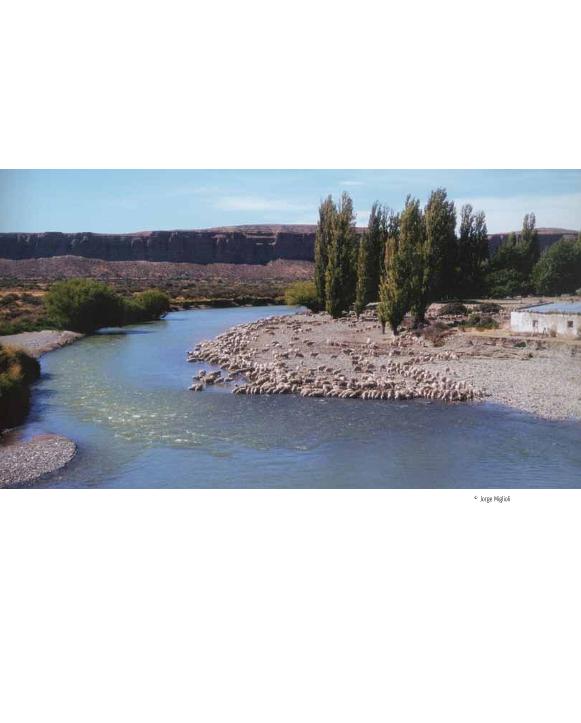Mostrar el registro sencillo del ítem
dc.contributor.author
Coronato, Fernando Raul

dc.contributor.author
Tourrand, Jean François
dc.date.available
2016-05-10T20:42:10Z
dc.date.issued
2015-06
dc.identifier.citation
Coronato, Fernando Raul; Tourrand, Jean François; Mouton, dessine-moi un pays: L’élevage ovin et l’identité régionale en Patagonie; CIRAD; Techniques & Culture; 2015; 63; 6-2015; 162-181
dc.identifier.issn
0248-6016
dc.identifier.uri
http://hdl.handle.net/11336/5617
dc.description.abstract
La Patagonie, extrémité australe des Amériques demeura terra incognita jusqu’à la fin du XIXe siècle, quand elle fut incorporée aux circuits politiques et économiques internationaux, et ceci grâce au développement de l’élevage ovin. La mise en valeur agricole de ces vastes steppes s’est faite à l’aide d’un élevage extensif qui s’est répandu en deux à trois décennies sur les quelques 800,000 km2 de la région. Le cheptel de Patagonie atteignit les vingt millions de moutons vers 1950, tandis que la population ne dépassait un million d’habitants qu’en 1980, de surcroît étant urbaine à 95 %. Même si d’autres activités économiques, notamment l’exploitation pétrolière, se sont développées tôt et ont contribué à la formation d’une société très cosmopolite, le mouton est à la base de la société patagonienne, car cette dernière s’est structurée autour de la filière ovine. Malgré le déclin de l’activité dans les dernières décennies du XXe à cause des crises économiques et environnementales, le caractère constitutif de l’élevage ovin dans la région explique la présence du mouton dans la symbolique régionale et sa persistance en tant que repère identitaire chez les Patagoniens.
dc.description.abstract
Patagonia, the southernmost tip of the Americas, was terra incognita until the end of the 19 th century when it was incorporated into international political and economic circuits thanks to the development of sheep breeding. The agricultural enhancement of these vast steppes is the result of extensive breeding that spread over the region’s some 800,000 km2 in just two to three decades. The Patagonian sheep herd numbered 20 million head by 1950, whereas the population of the region did not exceed one million inhabitants until 1980, 95% of them living in cities. Even if other economic activities, particularly oil drilling, developed early on and contributed to the formation of a highly cosmopolitan society, the sheep is at the core of Patagonian society, which is structured around the sheep sector. Despite the decline in activity in the last decades of the 20 th century because of economic and environmental crises, the constitutive nature of sheep breeding in the region explains the persistence of the sheep as a regional symbol and the fact that it is so closely linked to the identity of the Patagonian people.
dc.format
application/pdf
dc.language.iso
fra
dc.publisher
CIRAD
dc.rights
info:eu-repo/semantics/openAccess
dc.rights.uri
https://creativecommons.org/licenses/by-nc-sa/2.5/ar/
dc.subject
Sheep
dc.subject
Pioneers
dc.subject
Colonization
dc.subject
Socio-Economical Cycle
dc.subject.classification
Agricultura

dc.subject.classification
Agricultura, Silvicultura y Pesca

dc.subject.classification
CIENCIAS AGRÍCOLAS

dc.title
Mouton, dessine-moi un pays: L’élevage ovin et l’identité régionale en Patagonie
dc.type
info:eu-repo/semantics/article
dc.type
info:ar-repo/semantics/artículo
dc.type
info:eu-repo/semantics/publishedVersion
dc.date.updated
2016-04-28T14:50:30Z
dc.journal.volume
2015
dc.journal.number
63
dc.journal.pagination
162-181
dc.journal.pais
Francia

dc.journal.ciudad
Marseille
dc.description.fil
Fil: Coronato, Fernando Raul. Consejo Nacional de Investigaciones Científicas y Técnicas. Centro Nacional Patagónico; Argentina
dc.description.fil
Fil: Tourrand, Jean François. CIRAD; Francia
dc.journal.title
Techniques & Culture
dc.relation.alternativeid
info:eu-repo/semantics/altIdentifier/url/https://tc.revues.org/7475
dc.relation.alternativeid
info:eu-repo/semantics/altIdentifier/doi/http://dx.doi.org/10.4000/tc.7475
dc.relation.alternativeid
info:eu-repo/semantics/altIdentifier/doi/10.4000/tc.7475
Archivos asociados
